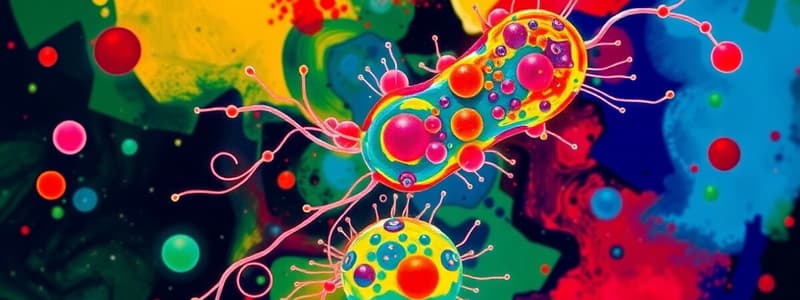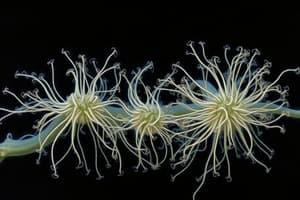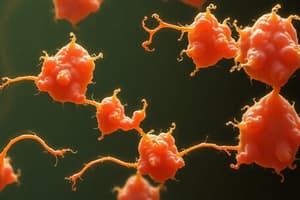Podcast
Questions and Answers
Why is catalase production important for Neisseria?
Why is catalase production important for Neisseria?
- Catalase protects Neisseria from oxidative damage. (correct)
- Catalase protects Neisseria from phagocytosis by neutrophils.
- Catalase is required for Neisseria to invade host cells.
- Catalase is essential for Neisseria's twitching motility.
What is the primary function of Type IV pili in pathogenic Neisseria?
What is the primary function of Type IV pili in pathogenic Neisseria?
- Acquiring iron from host transferrin.
- Facilitating twitching motility. (correct)
- Preventing phagolysosome fusion.
- Degrading immunoglobulin A.
How do Neisseria species acquire iron for their metabolism, differing from other bacteria?
How do Neisseria species acquire iron for their metabolism, differing from other bacteria?
- By degrading red blood cells to release iron.
- By utilizing porin proteins to import iron.
- By synthesizing siderophores.
- By binding directly to host transferrin, lactoferrin, and hemoglobin. (correct)
What role do Reduction-modifiable proteins (Rmp) play in Neisseria virulence?
What role do Reduction-modifiable proteins (Rmp) play in Neisseria virulence?
Why is the outer polysaccharide capsule in Neisseria meningitidis used in several vaccines?
Why is the outer polysaccharide capsule in Neisseria meningitidis used in several vaccines?
What is the function of Factor H binding protein (FHBP) in Neisseria meningitidis?
What is the function of Factor H binding protein (FHBP) in Neisseria meningitidis?
Which virulence factor is associated with penicillin resistance in some strains of Neisseria gonorrhoeae?
Which virulence factor is associated with penicillin resistance in some strains of Neisseria gonorrhoeae?
What is the primary mode of transmission for Neisseria meningitidis?
What is the primary mode of transmission for Neisseria meningitidis?
Individuals with which type of deficiency are especially at risk for meningococcal disease?
Individuals with which type of deficiency are especially at risk for meningococcal disease?
What is the most common cause of meningitis in individuals aged 2-18?
What is the most common cause of meningitis in individuals aged 2-18?
Which clinical manifestation is specifically associated with vascular damage leading to gangrene in severe cases of meningococcemia?
Which clinical manifestation is specifically associated with vascular damage leading to gangrene in severe cases of meningococcemia?
Which of the following is NOT a typical symptom of meningitis?
Which of the following is NOT a typical symptom of meningitis?
Which infection is NOT caused by Neisseria gonorrhoeae?
Which infection is NOT caused by Neisseria gonorrhoeae?
What is a common symptom of localized Neisseria gonorrhoeae infection in males?
What is a common symptom of localized Neisseria gonorrhoeae infection in males?
What complication can occur in females when a Neisseria gonorrhoeae infection ascends to the uterus and uterine tubes?
What complication can occur in females when a Neisseria gonorrhoeae infection ascends to the uterus and uterine tubes?
Which preventive measure is used to protect neonates from Ophthalmia neonatorum?
Which preventive measure is used to protect neonates from Ophthalmia neonatorum?
Which of the following best describes the appearance of Neisseria bacteria under a microscope?
Which of the following best describes the appearance of Neisseria bacteria under a microscope?
If a lab technician is trying to culture Neisseria gonorrhoeae from a sample, which type of agar is MOST suitable?
If a lab technician is trying to culture Neisseria gonorrhoeae from a sample, which type of agar is MOST suitable?
What is the role of IgA1 protease in Neisseria's pathogenic mechanism?
What is the role of IgA1 protease in Neisseria's pathogenic mechanism?
How do porin proteins (Por) contribute to the survival of Neisseria within neutrophils?
How do porin proteins (Por) contribute to the survival of Neisseria within neutrophils?
Why is vaccination against serogroup B Neisseria meningitidis more challenging?
Why is vaccination against serogroup B Neisseria meningitidis more challenging?
Which virulence factor of Neisseria contributes to its ability to attach to host cells and resist neutrophil bactericidal activities?
Which virulence factor of Neisseria contributes to its ability to attach to host cells and resist neutrophil bactericidal activities?
What is a key characteristic of Neisseria gonorrhoeae that contributes to its persistence and spread?
What is a key characteristic of Neisseria gonorrhoeae that contributes to its persistence and spread?
What condition is characterized by fever, chills, and skin pustules on the extremities, as a systemic manifestation of Neisseria gonorrhoeae infection?
What condition is characterized by fever, chills, and skin pustules on the extremities, as a systemic manifestation of Neisseria gonorrhoeae infection?
Which of the following is TRUE regarding the growth conditions of Neisseria?
Which of the following is TRUE regarding the growth conditions of Neisseria?
Flashcards
Neisseria
Neisseria
Gram-negative cocci that appear as paired coffee beans.
Catalase
Catalase
Protects bacteria from oxidative damage.
Twitching motility
Twitching motility
Bacterial motility associated with Type IV pili.
Neisseria meningitidis
Neisseria meningitidis
Signup and view all the flashcards
Neisseria gonorrhoeae
Neisseria gonorrhoeae
Signup and view all the flashcards
Lipooligosaccharide (LOS)
Lipooligosaccharide (LOS)
Signup and view all the flashcards
Pili
Pili
Signup and view all the flashcards
IgA1 protease
IgA1 protease
Signup and view all the flashcards
Opacity proteins (Opa)
Opacity proteins (Opa)
Signup and view all the flashcards
Reduction-modifiable proteins (Rmp)
Reduction-modifiable proteins (Rmp)
Signup and view all the flashcards
Porin proteins (Por)
Porin proteins (Por)
Signup and view all the flashcards
Neisseria meningitidis
Neisseria meningitidis
Signup and view all the flashcards
Factor H binding protein (FHBP)
Factor H binding protein (FHBP)
Signup and view all the flashcards
Neisseria gonorrhoeae
Neisseria gonorrhoeae
Signup and view all the flashcards
Pili and other adhesins
Pili and other adhesins
Signup and view all the flashcards
Meningitis
Meningitis
Signup and view all the flashcards
Meningitis (symptoms)
Meningitis (symptoms)
Signup and view all the flashcards
Meningococcemia
Meningococcemia
Signup and view all the flashcards
Waterhouse-Friderichsen syndrome
Waterhouse-Friderichsen syndrome
Signup and view all the flashcards
Neisseria gonorrhoeae
Neisseria gonorrhoeae
Signup and view all the flashcards
Neisseria gonorrhoeae (complications)
Neisseria gonorrhoeae (complications)
Signup and view all the flashcards
Opthalmia neonatorum
Opthalmia neonatorum
Signup and view all the flashcards
Systemic Gonococcemia
Systemic Gonococcemia
Signup and view all the flashcards
Study Notes
- Neisseria are Gram-negative cocci that often appear in pairs, resembling coffee beans.
- They are catalase and oxidase positive, which means they produce catalase to protect against self-induced oxidative damage.
- Pathogenic Neisseria use type IV pili for twitching motility and can invade host cells.
Overview
- Neisseria meningitidis, also known as meningococcus, includes pathogenic serogroups A, B, C, Y, and W-135, each responsible for geographically distinct epidemics and can grow on both chocolate and blood agar.
- Neisseria gonorrhoeae, also known as gonococcus, requires highly specific growth conditions and grows only on chocolate agar and can be isolated using selective Thayer-Martin chocolate agar with antibiotics.
Neisseria Virulence Factors
- Virulence factors are located in the cell wall.
- Neisseria endotoxin consists of Lipooligosaccharide (LOS) that contains toxic lipid A.
- Neisseria releases "blebs" of cell membranes containing endotoxin during infection.
- Pili is a key colonization step that attaches to host cells and resists neutrophil bactericidal activities.
- Type IV pili is used for twitching motility.
- IgA1 protease degrades Immunoglobulin A, helping the bacteria reach mucous membranes of the respiratory and genital tracts.
- Neisseria uses special receptors to bind host transferrin, lactoferrin, and hemoglobin to acquire iron.
- Opacity proteins (Opa) bind epithelial and phagocytic cells, engaging in cell to cell signaling.
- Reduction-modifiable proteins (Rmp) protect porin and lipooligosaccharide from bactericidal antibodies.
- Porin proteins (Por) create pores in bacterial cells allowing nutrients and wastes to pass and they also prevent phagolysosome fusion in neutrophils, and aid in intracellular survival thus invasion of epithelial cells.
- PorA is active only in Neisseria meningitidis.
- PorB is active in both N. meningitidis and N. gonorrhoeae.
- Opa, Por and Rmp proteins are outer membrane protein classes I-V in Neisseria meningitidis.
- Outer polysaccharide capsule in Neisseria meningitidis allows the bacteria to resist phagocytosis.
- Vaccines use this capsule as an immunogen, it is not effective for Group B meningococcus because its capsule is not immunogenic.
- Factor H binding protein (FHBP) binds Factor H to inhibit complement factor C3b which inhibits opsonization and membrane attack complex formation, is present on Group B meningococci, and is used as a vaccine immunogen.
- Some strains of Neisseria gonorrhoeae produce beta-lactamase (penicillinase) to promote penicillin resistance.
Neisseria Meningitidis
- Transmitted in airborne respiratory droplets, after entry pili and other adhesins promote adherence to the pharynx leading to bloodstream.
- Individuals with complement deficiencies are at risk for meningococcal disease.
- Some people are chronic carriers that can spread infection.
- Meningococcal diseases are preventable with vaccines, Infections can be treated with Cephalosporin or Penicillin G.
- Meningitis is inflammation of the meninges that cover the brain and/or spinal cord, which is most commonly caused by Neisseria meningitidis in individuals ages 2-18, Streptococci pneumoniae is also a major cause.
- Patients have fever, stiff neck, headache, and increased neutrophils in their cerebrospinal fluid.
- Meningococcemia is the presence of Neisseria meningitidis in the blood with or without meningitis, which is characterized by fever, headache, nausea, vomiting, and chills.
- Skin lesions start as small petechiae-like spots that coalesce into larger hemorrhagic areas.
- Vascular damage can lead to gangrene.
- Musculoskeletal pain is common.
- Adrenal gland hemorrhage (Waterhouse-Friderichsen syndrome) and thrombosis with vessel and organ damage can be fatal.
- Pneumonia can occur, particularly in older adults.
Neisseria Gonorrhoeae
- There is no vaccine.
- Sexually transmitted, causing local infections of the genitals, rectum, and pharynx; within the blood, it causes disseminated infection.
- Asymptomatic carriers are a key reservoir.
- In males, the most common site of infection is the urethra; purulent discharge is common with complications of epididymitis, prostatitis, and development of periurethral abscesses.
- In females, the cervix is the primary site of infection, many women are asymptomatic however can experience cervical discharge, abdominopelvic pain, and bleeding.
- Complications occur when infection ascends to the uterus and uterine tubes, resulting in pelvic inflammatory disease, where ectopic pregnancies and infertility occur as a result of scarring.
- Opthalmia neonatorum occurs when mothers pass gonorrheal infection to offspring during passage through the birth canal; leading affected neonates to acquire opthalmia neonatorum, which is a form of conjunctivitis that can be prevented with prophylactic use of erythromycin ointment shortly after birth.
- Systemic gonococcemia produces fever, chills, and skin pustules on the extremities and septic arthritis.
Studying That Suits You
Use AI to generate personalized quizzes and flashcards to suit your learning preferences.




